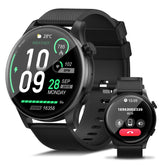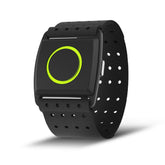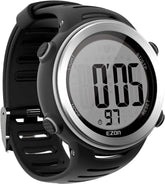Blood Oxygen Monitoring: The Science and Its Role in Fitness
Blood oxygen monitoring has emerged as a cornerstone of modern fitness tracking, offering insights into physiological performance, recovery, and overall well-being. This article delves into the science behind blood oxygen saturation (SpO₂) measurement, its implications for athletic performance, and how devices like the EZON sports watch integrate cutting-edge technology to empower users with actionable data.
The Science of Blood Oxygen Monitoring
Blood oxygen saturation reflects the percentage of hemoglobin molecules carrying oxygen in the bloodstream. During exercise, efficient oxygen delivery is critical for energy production, particularly in aerobic activities. Key mechanisms include:
Oxygen Utilization in Metabolism
Aerobic Exercise: Relies on oxygen to break down glucose and fat into ATP (adenosine triphosphate), sustaining prolonged efforts like running or cycling.
Anaerobic Exercise: Short bursts of high-intensity activity (e.g., sprinting) depend on glycogen stores without oxygen, but recovery requires oxygen to clear lactate buildup.
Studies (Physiological Control of Human Heart Rate and Oxygen Consumption during Rhythmic Exercises, 2014) highlight that maintaining SpO₂ above 95% optimizes aerobic efficiency, while levels below 90% signal potential hypoxia, impairing performance and recovery.
Measurement Technologies
Photoplethysmography (PPG): Most fitness tracker watches, including EZON’s models, use LED arrays and photodetectors to analyze blood flow and calculate SpO₂.
Multi-Sensor Fusion: Advanced devices combine PPG with accelerometers and skin temperature sensors to filter motion artifacts, enhancing accuracy during dynamic movements (Wrist02: Reliable Peripheral Oxygen Saturation Readings, 2019).
Non-Invasive Innovations: Emerging methods, such as radio signal analysis (Contactless Oxygen Monitoring with Gated Transformer, 2022), aim to eliminate direct skin contact, though wrist-worn PPG remains dominant for portability.
Why Blood Oxygen Matters in Fitness
Optimizing Training Intensity
Zone-Based Training: Monitoring SpO₂ helps athletes stay within aerobic thresholds (60–80% max heart rate). For example, a sudden drop in SpO₂ during HIIT may indicate overexertion, prompting adjustments to prevent fatigue.
Altitude Adaptation: Devices like the EZON R7 track SpO₂ to guide acclimatization strategies, reducing risks of altitude sickness during mountain activities.
Recovery and Overtraining Prevention
Post-Workout Recovery: Low SpO₂ during rest may signal incomplete recovery or respiratory issues. EZON’s Recovery Pro Algorithm correlates SpO₂ with heart rate variability (HRV) to recommend rest days or lighter sessions.
Lactate Clearance: Efficient oxygen delivery accelerates lactate metabolism post-exercise, reducing muscle soreness
Health Risk Mitigation
Hypoxia Detection: Chronic low SpO₂ (<90%) may indicate sleep apnea or cardiovascular issues. EZON’s SafeOxygen Alert vibrates to warn users during sleep or intense workouts.
Brain Health: Improved cerebral oxygenation through exercise correlates with reduced neurodegeneration risks (Enhancing the Understanding Between Exercise and Brain Health, 2024).
EZON Sports Watch: Bridging Science and Performance
The EZON blood oxygen monitor watch integrates research-driven innovations to deliver real-time insights:
Dynamic SpO₂ Tracking
AI-Powered Adjustments: Adapts measurement frequency based on activity type (e.g., continuous monitoring during runs vs. periodic checks during yoga).
Hybrid GPS + SpO₂ Mapping: Overlays oxygen levels onto route elevation data, helping hikers manage exertion in high-altitude zones.
Advanced Features
Metabolic Efficiency Score: Rates workouts by how effectively oxygen is used to burn fat versus carbs, aligning with goals like weight loss or endurance.
Hydration Synergy: Links SpO₂ trends with sweat rate data to recommend fluid intake, preventing dehydration-induced oxygen desaturation.
Battery and Durability
Solar Assist Mode: Extends GPS + SpO₂ tracking to 40 hours, ideal for ultramarathons.
MIL-STD-810H Certification: Withstands extreme temperatures (-30°C to 60°C) and water submersion (10ATM), ensuring reliability in harsh environments.
Future Trends in Blood Oxygen Tech
Glucose-Oxygen Correlation: EZON prototypes (2026) aim to link SpO₂ with non-invasive glucose monitoring, optimizing fueling strategies for diabetics and athletes.
Genomic Integration: Personalized SpO₂ targets based on genetic markers for oxygen utilization efficiency.
Practical Tips for Users
Pre-Workout Baseline: Measure resting SpO₂ each morning; a 3–5% drop may indicate illness or fatigue.
Interval Training: Use EZON’s Zone Coach to alternate high/low SpO₂ intervals, boosting aerobic capacity.
Altitude Training: Gradually increase elevation while monitoring SpO₂ to enhance red blood cell production.
Final Thoughts
Blood oxygen monitoring transcends basic fitness tracking, offering a window into metabolic health and performance limits. By leveraging the EZON sports watch, athletes gain a tool that marries scientific rigor with practical insights—turning every heartbeat and breath into a step toward peak potential.









